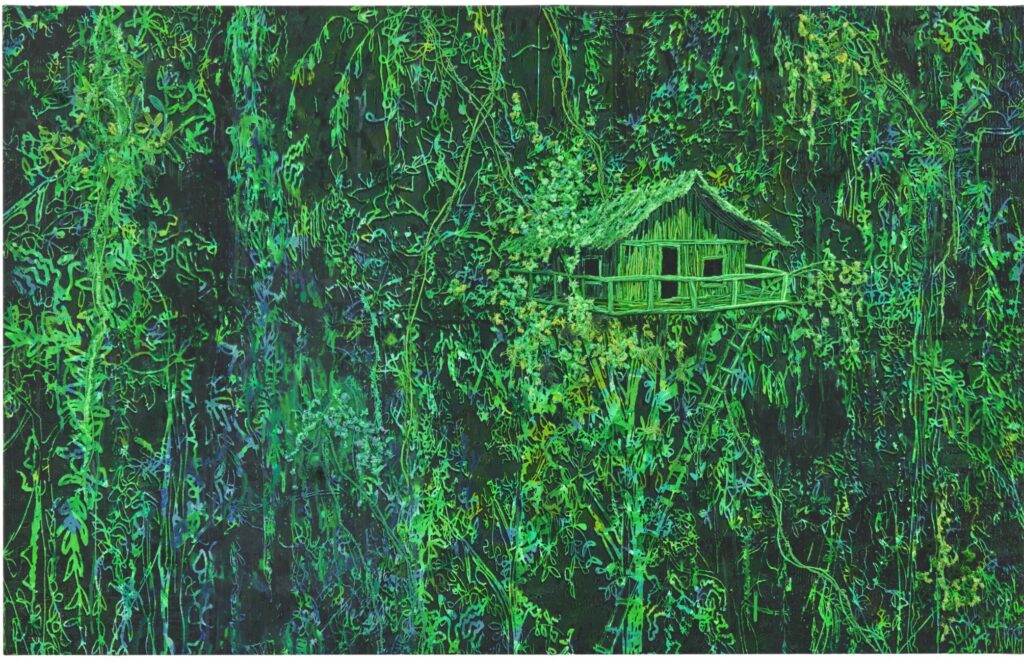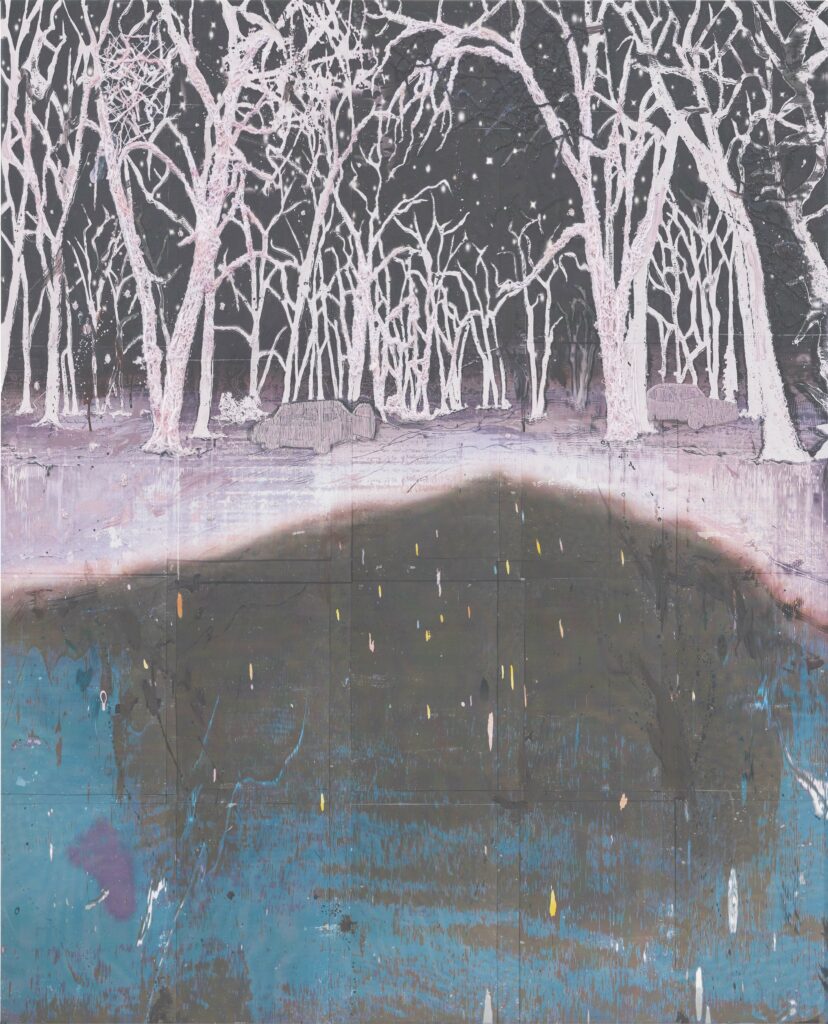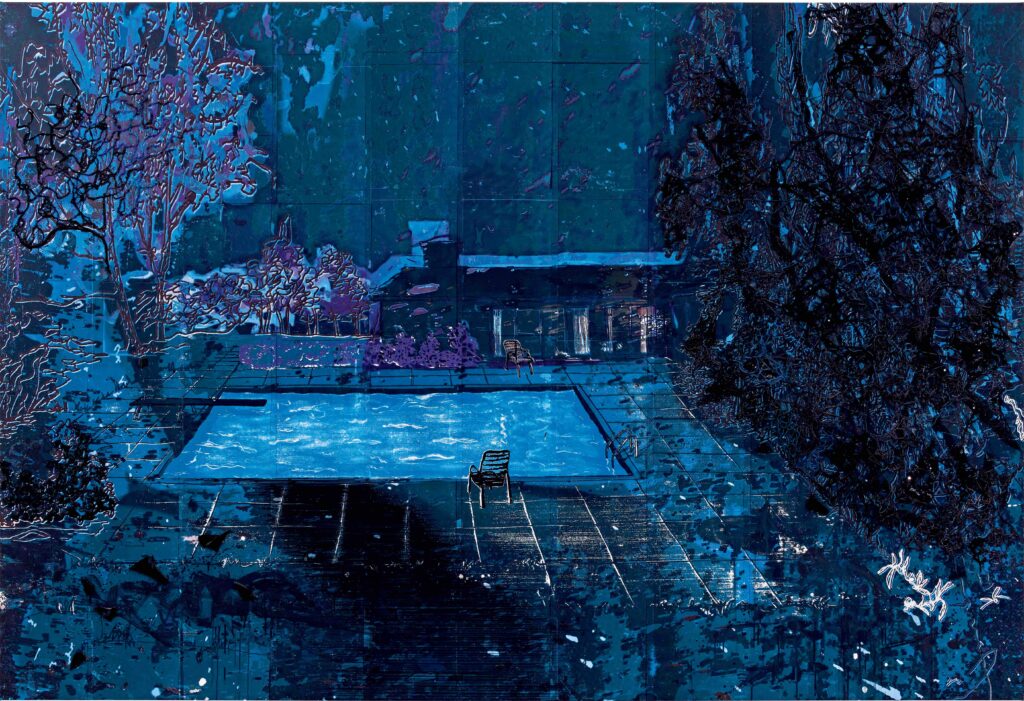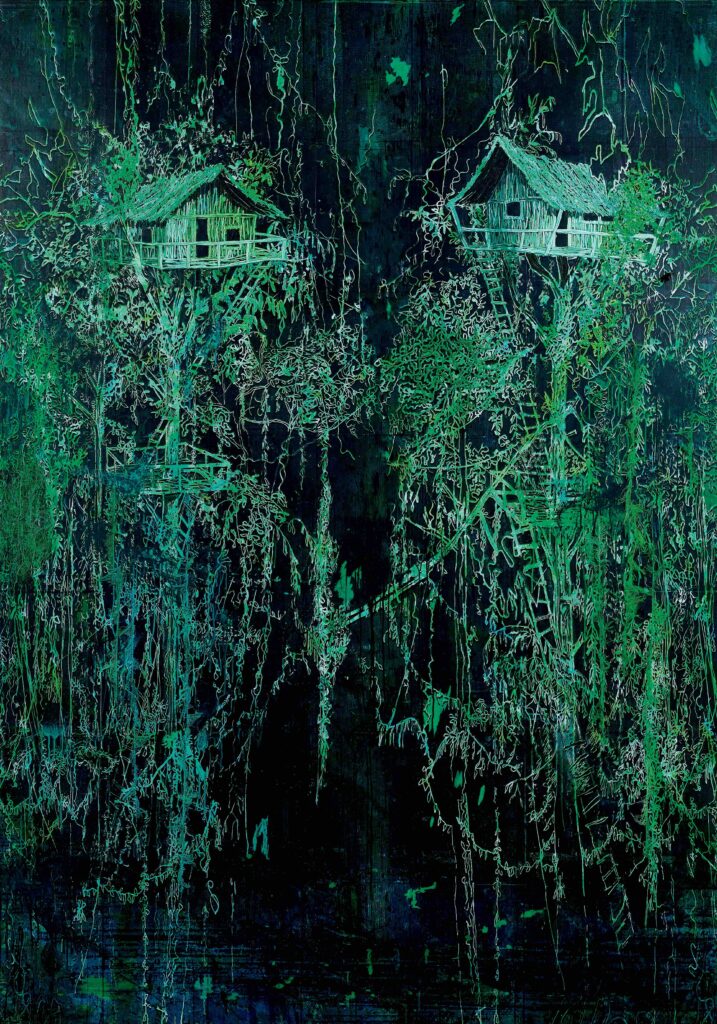Inertia

Michael Raedecker, solo 2021. Courtesy of the artist.
In a novel that she had been trying to read the night before, she’d read the description of a late spring day as a glittery day, and she thought of that as she was walking with her daughters, and the dog, up through the boulevards. It was turning from a warm into a hot day, even though it was still morning, and not yet summer. The dog was panting, and they took a break, to drink their bottles of water thrown underneath the stroller. There was something filmy to the skin of her daughters, she had dressed them that day in their lightest clothes, and later, she had promised, they could put on their swimwear at the local splash pad. Before leaving she had quickly pulled their hair off their faces, and now they kept on taking off their hats and handing them to her, and she would throw them in the bottom of the stroller. They needed to get their hair washed tonight, she observed, as she looked at them, their curls greasy with sunscreen. The children had decided they wished to dress alike, or in corresponding colors, and today they were wearing shades of yellow. They were mostly quiet, strolling down the street, the older daughter riding on the attached wooden platform with wheels that trailed behind the stroller that they called the skateboard. She had found a piece of dark yarn and was finger-knitting with it, which she loved to do, or tying a piece of yarn into knots, or wrapping it around and around a stick. It was beginning to be the kind of heat in which one went about in a daze. Sometimes the children wanted to get out to walk and she would hold their hands while their father pushed the stroller, which was laden with provisions for the day. It was such a beautiful walk that morning. The green of the bushes and the trees at this time of year seemed lush and overgrown. Because of this green canopy they were in the shade most of the time, until they had to cross major streets and intersections. She felt that they were walking in a bright encroaching greenness, and had the sensation that they were alone with the trees and the gardens. When she got home she was supposed to work on an essay she had been commissioned to write, on an artist who painted landscapes that felt wild and overgrown like this while remaining strangely suburban. His green paintings felt like they were set in the middle of a forest, often enhanced with black glitter, iridescent beads, and black and green embroidery. There were no figures in his paintings, although there was a narrative, however mysterious, and suggestions of places where children were once playing, or, perhaps, of the abandoning of these spaces, for an unknown reason. There were cars parked outside with their doors left ajar, pairs of tents and treehouses, chairs overturned. This interested her more and more, the strangeness of an emptied landscape, and how then to write of this emptiness.

Michael Raedecker, koan 2023. Courtesy of the artist.
One day recently, during the baby’s nap, she had read a book on eeriness, which suggested that the eerie takes place within a silent and unpeopled landscape. Because she had been thinking of these paintings by this artist she didn’t know who lived elsewhere, on this walk she realized she was beginning to see the outside world like his visions, that it had taken on their strangeness. The landscape in which she was walking with her family that morning appeared to glow. In the novel she had been trying to read the night before, a woman keeps seeing a figure in green everywhere she goes, and reading it she thought that she’d love to write a text to attempt to speak to these abandoned landscapes that glowed green, like a strange green light. On their morning walk she remarked to her family that it was so strange that there was no one around. It was so silent out, except for birdsong. She had a thought—that the landscape they were walking through was like the paintings she was supposed to write about, except there was no birdsong in the paintings. Or perhaps there was, the thought continued, but she couldn’t hear it in the silence of the gallery in which she had originally seen them, with only the sound of her children and of her footsteps on the creaky wooden floors. On the long walk they passed almost no one else on the sidewalk, if anyone at all. Perhaps it was because it was morning, her husband remarked. Or perhaps the heat. Maybe everyone was inside, in the blast of air-conditioning already, having no desire for the outside. But there were still so many cars on the street, she replied. More likely those families who lived in the large houses went to other large houses on the weekend, especially for the holiday, large houses that were even more remote, more rural, even more beautiful. But when did they enjoy their gardens? Today, because of the holiday, there were none of the crews working outside, as there had been the day before, none of the fumes or roars of their lawnmowers and leaf blowers that were so noxious to walk by. She waved at a sole woman who was gardening outside, a sturdy homeowner who had most likely been in that neighborhood forever, before the change. The beauty and care of the gardens here always surprised her, especially in the intensity of early summer. There was a wildness to so many of them, especially now, at the peak, the overgrown rosemary, the reds and pinks of the rosebushes, the fragile tendrils of peonies jutting out. She knew that there was artifice to this wildness, that it was cultivated, but still she felt thankful for its beauty. Lately she had felt overcome by the visual splendor of the flowering trees outside of the large houses, the surprise to these full open flowers, almost obscene. It made her feel dizzy, or perhaps it was the heat. She hadn’t drunk enough water that morning, after coffee. The day before at the farmers’ market she had purchased two bunches of peonies, such as were flowering now, one fuchsia and light pink and the other pure white with speckles of pink. They had spent the day watching them, enjoying them, and wondering whether ants would be needed to open the few remaining closed bulbs in the bouquet. This morning her oldest daughter and her husband had placed an ant from the sticky kitchen counter on one of the flowers, as an experiment. When she had first seen the paintings of this artist, on the walls of a gallery, while she was wearing the baby, holding the hand of her daughter, she felt moved by them, especially by the flowering trees, embroidered with hectic and voluptuous clusters of red and pink thread. There were also all of his pool scenes, with the chlorinated light of the blue, that she thought of the day before, when they had proceeded on their walk in the other direction, toward the larger mansions near the park, and passed by the house on the corner where her daughter had attended a birthday party almost exactly one year earlier, as she had been in the same preschool class that spring with the boy who lived there, with his older brother and their parents. The preschool had taken place mostly in the park, in the style of forest school that became popular last year, and they were sent videos by the teachers of children, bored and hot, standing near a monument or excitedly playing in the nook of a tree. Her daughter had joined much later, and was an outsider to the group, but still was excited to be invited to the birthday party, especially because of the pool. The mother had been incredibly nervous, outside of her skin, for her daughter, who couldn’t swim, swim classes being almost entirely closed the past two years, and was swimming around in the artificially bright blue hole of water, with the shudder of its waves, and so she had purchased her a life jacket for the occasion and insisted she wear it. The horror and terror of the pool, and yet how inviting it was, its coolness. The father, who was much calmer about such things, was the one to take her, but then she joined with the baby later, wearing a long muumuu with painted flowers, walking by the blue-tinged hydrangeas that hadn’t appeared yet, so it must have been a little later in the year. When she came upon them at the party her daughter was so incredibly happy in the pool, her skin having that soaked, buoyant feeling children getwhen they are swimming, but she could hardly watch her, teeth chattering, swimming around and around in a circle, her life jacket not worn, clutching a pink foam noodle. What a luxury, to have a pool, she thought then, and also yesterday, as they walked by the house, past the gridded gate, and heard sounds of children playing and splashing inside, although they couldn’t see anything. Pools have to be fenced in, otherwise children would drown, her husband said to her in response, or something to that effect. It was the first time they had heard the family out in the pool that spring. When they got home from their walk the day before, she sat on the steps and watched the girls gleefully chase after the bubbles their father was blowing, the youngest especially desperate to catch one. They were framed by the green overgrown bushes in the front garden, and when she narrowed her eyes, she could imagine a field of green, with only the iridescence of the floating bubbles.

Michael Raedecker, topophilia 2023. Courtesy of the artist.
Staring at them, spacey, she thought perhaps she was seeing a painting. Her thoughts were filled with thinking of her children, of the future for children. The other day someone, another writer, who also had two children, had written to her, that perhaps they would all be living in the woods in five years, and she had thought of that, and somehow it got confused with the green overgrowth of the paintings she was thinking about. Away from some impending violence, and from the city, it was implied, and toward safety, although she knew, in that overgrowth, in those woods, there was violence as well. The next day her husband took the girls to the playground as she sat on the couch and tried to think about these paintings. She kept on being sent zip files to download of images of the paintings, even close-ups of the various textures, but they kept on disappearing because she would forget to look at them and then not know where the files had downloaded, so she kept on having to download them again. She couldn’t focus, clicking through the paintings on a screen, or focus on thinking about writing about painting, and she kept on refreshing the news over and over. She looked at a notebook, which also featured her children’s scrawled drawings and writings, and tried to read notes that she had written after reading an essay on writing about art that was written by a friend of hers. She couldn’t decipher most of her own handwriting, with its knots and swoops, like it was alien to her. There was a passage she had written down, “much like a tunnel or glittering vortex I’m talking about a pulling through of strangeness into strangeness,” and she kept thinking about this, about how to pull strangeness into strangeness. It felt like a connection she should follow, that she kept on reading about glitter. Was the glitter in the painting or the writing? What did this mean, glittery writing? She had wondered too, in this essay she was supposed to write, whether the paintings had to be in there. Should the paintings be here, in her writing? Or had they been diffused everywhere, in the atmosphere, in the air she breathed? She kept on trying to find these images of the paintings on her desktop and then chose not to look at the paintings or rather at the photographs of the paintings anymore. She needed to go outside.

Michael Raedecker, parallel visitation 2023. Courtesy of the artist.
Outside was somehow where the paintings were, not inside. She decided to meet the children at the playground, off of the main thoroughfare in the neighborhood. As she began to turn onto the sidewalk, away from the streets with trees where they had been walking, there were now people everywhere. People, trash, dogs, street vendors, strollers of babies, boxes of groceries being loaded, people pouring out from the train. It was so much hotter, without the shade. She found herself wondering whether the artist in his summers experienced heat like this. There was an energy to his paintings that felt like humidity. She sat on the bench and watched the chaos of children gathered around the water spilling out from the spout, running around, yelling. After a while, they walked home, slowly, and sat on the porch, and she watched a smear of pink from the popsicle melt on the little tender face of her youngest. Inside, while dinner was being made, she watched the children, while trying to think of these paintings, and was somehow unable to stop her toddler from grabbing her pen and the book she was reading and take them only a short distance away to sketch inside of it. She was not able to grab the book back until it was too late. It was like she was stuck there, lost in her own inertia. She opened the book to see the scrawl across, and was somehow comforted that it was a passage about the writer’s young children, on page seven: “It’s also the nearness of that banana tree, of course, with its leaves so broad that any of them could enfold my youngest child, it’s also the imminence of a discovery. A golden dust floats above their heads. Their foreheads are curved and serene, their napes still pale.” Later that evening, after dinner, she sat outside, in the back, and stared at the green everywhere, almost like staring in the middle of a hole. It was silent, back there, except for the sounds of dogs barking, the joyous and sometimes incensed sounds of her daughters inside. She remembered when her first daughter was very young, she had begged their landlord to fill in the koi pond that he had dug into the ground beside the deck, and she asked that he transplant the koi elsewhere. She had visions constantly of her toddler daughter stumbling out there and drowning in the koi pond. They finally paid to have it filled in. There was now no sign of it anywhere, except for a thermometer that remained tied to the trunk of the Japanese maple that reached partly over the deck. She couldn’t imagine it having been there. All there was to stare at was green. Perhaps here, she thought, there was the hope of recovering the paintings in the landscape. In this outdoors that wasn’t really outdoors. She stared there for some time and wrote a few words. She heard one of her daughters screaming, in the bath, and went inside to help, spending time untangling the mass of a knot in her long hair.
This story was written at the invitation of Michael Raedecker, to be included in a monograph of his work, to be published by Phaidon in July. I first encountered his paintings at the GRIMM gallery in New York City, in March 2022. His work is currently showing at the GRIMM gallery in London, through May 20.
The novel quoted in this story is Marie NDiaye’s Self-Portrait in Green, translated by Jordan Stump.
The essay on eeriness referenced here is Mark Fisher’s The Weird and the Eerie.
The essay on ekphrasis and writing quoted here is Danielle Dutton’s A Picture Held Us Captive.
Kate Zambreno is the author of The Light Room, a meditation on art and care, forthcoming from Riverhead in July 2023. Tone, a collaborative study written with Sofia Samatar, is forthcoming from Columbia University Press in November 2023. She is at work on a book of fiction, Realisms, as well as a series on zoos.
Copyright
© The Paris Review
